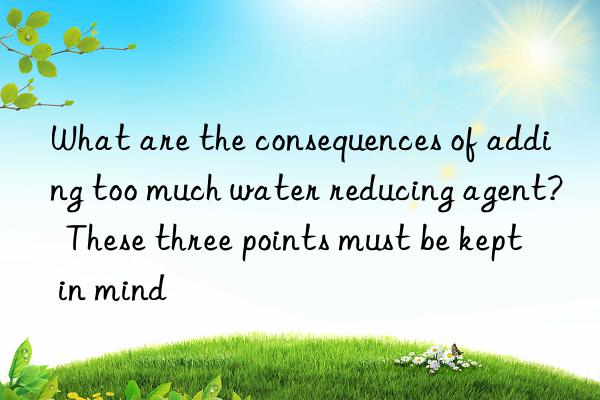
What are the consequences of adding too much water-reducing agent? Because of human error, if the dosage is too large or small, or does not follow the standards, it will affect quality problems. If too much water-reducing agent is added to concrete, excessive slump and stone segregation will occur. Segregation, bleeding, etc. will affect the quality of concrete and have immeasurable consequences.
Water reducing agent is a concrete admixture that can reduce the amount of mixing water while maintaining the slump of concrete. Most of them are anionic surfactants, including lignin sulfonate, naphthalene sulfonate formaldehyde polymer, etc. After being added to the concrete mixture, it has a dispersing effect on the cement particles, which can improve its workability, reduce the unit water consumption, and improve the fluidity of the concrete mixture; or reduce the unit cement consumption and save cement.
According to the water-reducing and enhancing capabilities of water-reducing agents, they are divided into ordinary water-reducing agents (also known as plasticizers, the water-reducing rate is not less than 8%, represented by lignosulfonates), high-efficiency water-reducing agents Water-reducing agents (also known as superplasticizers, the water-reducing rate is not less than 14%, including naphthalene series, melamine series, sulfamate series, aliphatic series, etc.) and high-performance water-reducing agents (the water-reducing rate is not less than 14%) 25%, represented by polycarboxylic acid superplasticizer), and are divided into early strength type, standard type and retardant type.
First of all, avoid long-term contact with iron materials during use, because the polycarboxylate water-reducing agent is acidic, and if it comes into contact with iron materials for a long time, it may react slowly and sometimes cause polymerization. The performance of carboxylic acid superplasticizer changes. If you use a metal container to store polycarboxylic acid superplasticizer, it is best not to store it for more than half a year.
Secondly, when using it, you must strictly calculate the water reducing agent and mixing water. You should strictly follow the water consumption determined by the laboratory. Do not increase or decrease at will to avoid undesirable phenomena. Affect the normal construction and pouring quality of concrete.
Thirdly, the polycarboxylate water-reducing agent has a relatively small impact on the dry shrinkage properties of concrete during use, but this does not mean that the concrete mixed with the polycarboxylate water-reducing agent does not need to be cured. Early maintenance should be strengthened to prevent cracking.
Polycarboxylate water-reducing agent is a highly efficient water-reducing agent that can be used in ready-mixed and precast concrete. It can effectively reduce the shrinkage and shrinkage of concrete during use. Improve the durability of concrete.
</p

 微信扫一扫打赏
微信扫一扫打赏

